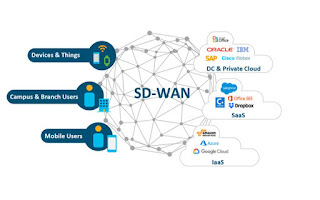The software-defined wide-area
network (SD-WAN or SDWAN) is a specific application of software-defined
networking (SDN) technology applied
to WAN connections, which are used to connect enterprise networks –
including branch offices and data centers – over large geographic distances.
A WAN might be used, for example, to connect
branch offices to a central corporate network, or to connect data
centers separated by distance. In the past, these WAN connections often used
technology that required special proprietary hardware. The SD-WAN movement seeks to
move more of the network control is moved into the “cloud,” using a software
approach.
Software-Defined WAN
(SD-WAN or SDWAN)
SD-WAN (SDWAN) Business Drivers
Enterprise customers are demanding more
flexible, open, and cloud-based WAN technologies, rather than installing proprietary or specialized WAN technology
that often involves expensive, fixed circuits, or proprietary hardware.
Many of the new software-defined WAN offerings,
for example, can be used to improve and secure Internet connectivity, making it
more competitive with more expensive legacy WAN technologies such as T-1 or
MPLS. In some cases, software-defined WAN technology uses Internet broadband
connections to replace more expensive solutions. Virtualization technology can apply security and virtual private
networking (VPN) technology to
broadband Internet connections, making them more secure.
Software-Defined WAN also has the advantage of
removing potentially expensive routing hardware by provisioning connectivity
and services via the cloud. Emerging SD-WAN technology can also be more flexible. For
example, because SD-WAN connectivity can be controlled through cloud software, a
customer might be able to scale up or “burst” connectivity during times of peak
demand.
Customer Focus: Cost, Reliability, Security
The main goal of SD-WAN (SDWAN) technology is to
deliver a business-class, secure, and simple cloud-enabled WAN connection with
as much open and software-based technology as possible. This can be used to
deliver basic WAN connectivity, or it can be used for premium business services
such as VPN, WAN optimization, and applications delivery control (ADC).
Many new startups are going after the potential
in the software-defined WAN market, which is likely billions of dollars. Many of these startups have
slightly different approaches to the market. For example, Silver Peak has
focused on accelerating Software-as-a-Service
(SaaS) applications in the cloud, VeloCloud goes after branch-office connectivity, and Aryaka has built
a global network so that companies can use WAN as a Network-as-a-Service
(NaaS).
Incumbent WAN technology vendors such as Cisco
and Riverbed, which make specialized appliances for WAN connectivity, are now
focusing more on cloud-based WAN offerings in response to this new trend.
Expect the trend to accelerate over the next few
years. What started as a solution for branch-office and data-center WAN
connectivity requiring less proprietary equipment appears to be expanding into
a wide range of SD-WAN (SDWAN) offerings and technologies including VPN, security, WAN optimization, NaaS, and application policy control.

Comments
Post a Comment